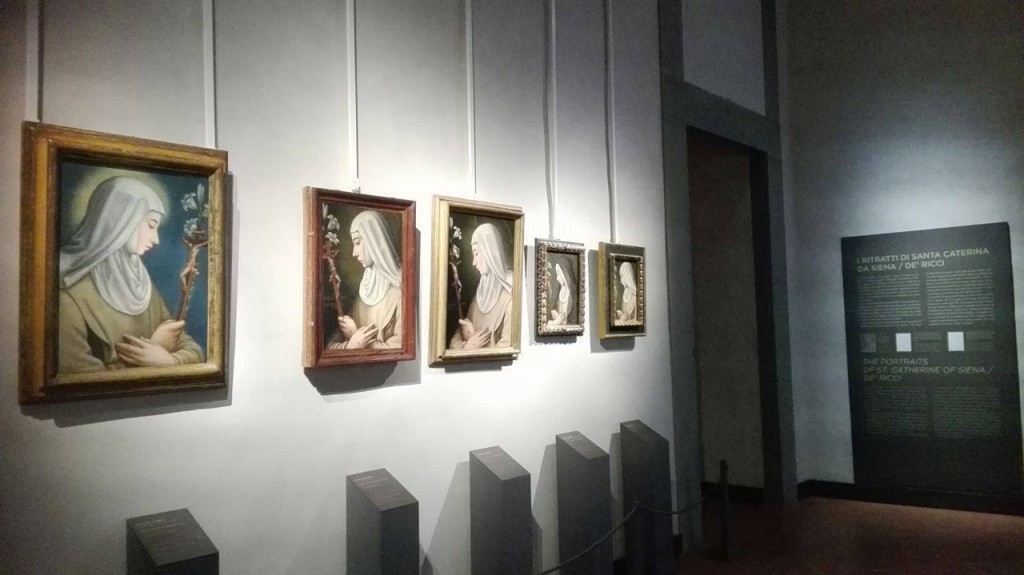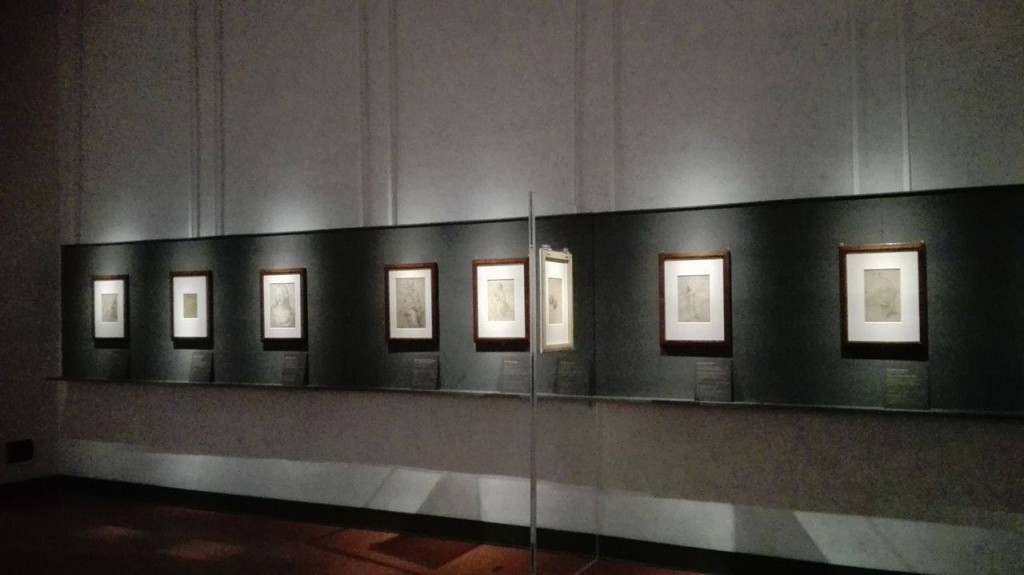
Firenze, Galleria degli Uffizi
8 marzo – 4 giugno 2017
Di Simona Anna Vespari (Università degli Studi di Firenze)
Plautilla Nelli. Arte e devozione in convento sulle orme di Savonarola è la mostra curata da Fausta Navarro che si è svolta dall’ 8 marzo al 4 giugno alla Galleria degli Uffizi. La data di inaugurazione non è casuale: si apre con essa una serie di iniziative che il direttore del museo Eike Schmidt propone di rinnovare ogni anno, rendendo omaggio, di volta in volta, ad artiste che per lungo tempo sono rimaste sconosciute o poco considerate. Un’occasione quindi per scoprire nuovi nomi a lungo dimenticati nel panorama artistico.
Va subito detto che, però, per essere la prima monografica sull’artista, la mostra ha la grande pecca di non esporre le sue opere certe: grande mancanza che rischia di dare al visitatore una conoscenza approssimativa dell’artista.
La mostra si compone di quattro sale sulle cui pareti sono disposti pannelli esplicativi in doppia lingua, italiano e inglese, utili per inquadrare la figura di Plautilla Nelli nel suo contesto storico e culturale. Nella prima sono esposti sulla stessa parete i quattro ritratti di Santa Caterina da Siena / De Ricci conservati tra Firenze, Siena, Perugia e Assisi raffiguranti la stessa santa ritratta di profilo, ai quali si aggiunge una copia successiva di altro artista che dimostra una certa fortuna iconografica del modello ideato da Plautilla. Questo allestimento è utile e accentua la serialità delle opere su cui si vuole puntare l’attenzione: la medesima posizione in cui la santa è ritratta in tutte e quattro le opere è chiaro indice di una produzione seriale basata sull’impiego di uno stesso cartone, dal quale veniva poi trasferito il disegno sul supporto tramite una tecnica detta “spolvero” : anche in questo caso l’ausilio dei pannelli è funzionale al visitatore, il quale può comprendere meglio anche questi dati più tecnici. Non è dato sapere però se la disposizione dei quattro ritratti sulla parete sia avvenuta seguendo una successione cronologica, in quanto nelle relative didascalie non ne viene riportato il riferimento.
Utile al visitatore per una maggiore conoscenza dell’artista è la visione del breve filmato proiettato nello spazio antecedente l’ultima sala: in inglese, sottotitolato in italiano, vengono spiegate dagli studiosi le ricerche che si sono condotte sull’artista anche attraverso i vari restauri, l’ultimo dei quali vede interessata la grande Ultima Cena. In questa sala troviamo un pannello sul quale sono riportate le varie opere conservate in altri musei a Firenze e non presenti in mostra, pannello che si spera sia da stimolo al visitatore per andarle a visitare.
L’ultima sala, infine, è dedicata all’attività grafica dell’artista. I disegni risaltano disposti su uno sfondo grigio e di particolare interesse è il confronto presentato tra un disegno di Fra Bartolomeo e uno di Plautilla Nelli, entrambi raffiguranti una Madonna con Bambino, che dimostra la vicinanza della nostra artista al frate pittore.
L’intento della mostra sembra quello di far entrare il visitatore nel contesto culturale e sociale in cui Plautilla Nelli è vissuta, anche attraverso l’esposizione di testi antichi che si concentrano sulla figura di Girolamo Savonarola e di alcuni manufatti provenienti dal convento di Prato che quindi mostrano il legame con la forte religiosità dell’artista. Complessivamente l’esposizione è ben curata: le opere sono ben visibili, ben illuminate ed esposte a un’altezza tale che ne permette la visione ravvicinata e lo studio. A prescindere dalle considerazioni prettamente attributive che si potrebbero fare, si tratta di una mostra che nonostante le evidenti mancanze a cui abbiamo accennato sopra, ha sicuramente il merito di far conoscere al grande pubblico, troppo spesso attratto solo dai grandi nomi del panorama artistico fiorentino, un’artista pressoché dimenticata.

Translation by Rachyl Grussing (Istituto Lorenzo de’Medici)
Plautilla Nelli: Art and Devotion to the Convent in the Footsteps of Savonarola is the exhibition curated by Fausta Navarro that takes place from 8 March and 4 June at the Uffizi Gallery. The inauguration date is no accident: it opens with a series of initiatives that the director of the museum, Eike Schmidt, proposes to renew each year, paying tribute to artists who, for a long time, have remained unknown or little considered. This is an occasion to find new, long forgotten, names in the artistic landscape.
It is immediately said that, however, to be the first monograph on the artists, the exhibition has the great fate of not exposing his own works: a great lack that risks giving the visitor an approximate knowledge of the artist.
The exhibition is composed of four rooms, on whose walls are explanatory panels in two languages, Italian and English, which are useful for framing the figure of Plautilla Nelli in its historical and cultural context. In the first room are exposed, on the same wall, the four portraits of Saint Catherine of Siena/ De Ricci, preserved between Florence, Siena, Perugia and Assisi, depicting the same sacred profile portraiture, to which a subsequent copy of another artist showing a certain fortune iconographic model created by Plautilla. This set-up is useful and accentuates the seriality of the works on which the attention is to be drawn: the saint is portrayed in the same position in all four works – a clear indication of a serial production based on the use of the same cardboard from which the design was then transferred to the support by means of a technique known as dusting. In this case, the use of the panels is functional to the visitor, to better understand this technical data. However, it is not known whether the layout of the four portraits on the wall was done following a chronological sequence, since the references are not included in the corresponding captions.
Helpful to the visitors greater knowledge of the artist is the vision of the short film projected in the space before the last room: in English, subtitled in Italian, the scholars explain the research that has been carried out on the artist and the various restorations, the last of which is concerned with the great Last Supper. In this room we find a panel showing the various works preserved in other museums in Florence and not present in the exhibition, hoping to stimulate the visitor to visitor them.
Finally, the last room is dedicated to the artist’s graphic activity. The drawings stand out on a gray background and is of particular interest to the comparison presented between a drawing by Fra Bartolomeo and one by Plautilla Nelli, both depicting a Madonna with Child, which shows the proximity of our artist to the painters brother.
The intent of the show seems to be to bring the visitor into the cultural and social context in which Plautilla Nelli is lived through the exposition of ancient texts that focus on the figure of Girolamo Savonarola and some artefacts from the convent of Prato. They show the strong religiousness of the artist. Overall the exhibition is well-groomed: the works are well visible, well lit and exposed to a height that allows close vision and study. Regardless of the purely attributive considerations that could be made, this is an exhibition that, despite its obvious shortcomings mentioned above, certainly deserves to be known to the general public, too often attracted only to the great names of the Florentine artistic landscape, to know an almost forgotten artist.